What Happened To My Seed Germination?
Seed Germination – Challenges and Rewards
Seed germination issues happen every spring and challenge many new and experienced gardeners and growers. Over the years we have found a lot of commonality in why our customers have problems with seed germination. The four biggest issues are soil temperature, moisture levels, knowledge or experience and patience. We’ve put this guide together to help everyone learn where the problems lie and make changes to become more successful.
We have a vested interest in you being successful both in starting seeds and in your gardening efforts. After all, we put our name and reputation on each and every one of the seed packets we send out. If you fail, we also fail; so we really want to help you succeed!
We know our seed quality and spend a lot of time, energy and effort to make sure you get the best possible seeds. When you have problems with seed germination, if we simply send you replacement seeds without helping to correct the issues, you will get the same results and no one will be happy! We aren’t asking these questions to make things difficult, but to help you. Also, if you learn some of these critical skills and steps, you will be much more successful overall.
Seeds are amazing; they have everything needed to continue their species stored right inside their seed coats. From their accumulated travels they have all the adaptations, the environmental and seasonal conditions they have encountered and grown through encoded into their DNA. Everything they need to sprout when the time is right is built right inside their shells. Within that hard seed coat is enough food energy to help them break dormancy and carry them into their first several days as seedlings. All the enzymes they need to convert the stored energy into food is there as well; they have the fats, carbohydrates, protein, enzymes and hormones needed to get the seed off to a great start. As home gardeners and small scale growers, our job is to provide the proper conditions, ensuring maximum germination into strong and healthy seedlings ready to be transplanted into the garden when the conditions are right.
Seed Germination Basics – What You Need To Know
Not all seeds are alike; likewise, many of them need somewhat different conditions to germinate. Some seeds are simply more difficult to germinate and require patience, attention to detail and time to be successful with. Pay attention to the seed packet directions – if it says, “Outdoor sowing recommended,” there is a reason! You will have a much harder time getting them to start inside, regardless of the professional greenhouse set-up you might have. Corn, melons and cucumbers are great examples.
Other seeds really need to be planted in the fall, lightly covered with soil and left alone – like most herbs and flowers. Duplicate the natural systems of seeds scattering in the fall and overwintering in the soil, then sprouting in the spring, and you will have less work and worry with a better, more vibrant garden.
Very few varieties of seed will have 100% germination. Under carefully controlled conditions, we might see 97% germination rate for tomatoes, but you might see 90% in your home. This doesn’t mean the seeds you get are weaker, just that your conditions are most likely different than what we used in our germination tests. We always beat the Federal Germination Standards!
This is why we pack more seeds in a packet for some varieties; it reflects the Federal germination rate. For instance, the standard germination rate for Okra is 50% – which is why we give you around 100 seeds – there is plenty of seed to ensure an abundant harvest. The minimum germination rate for peppers is 55% – we will stop selling it long before it drops to 70% in our tests. This is one of the reasons we pack 40 seeds per packet for peppers, as not all will germinate. We pack our seeds to give you the best germination rate possible, combined with our knowledge of how that variety grows to ensure a great crop in your garden; another reason to wonder what results you will get with 10 seeds per packet from other companies.
What Happened To My Seed Germination?
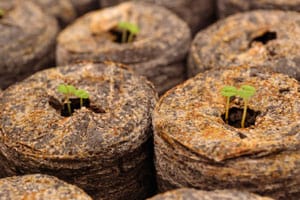 Now that we have some information, where do we start in evaluating why our seed germination failed? When seed germination doesn’t happen, there are a few things to consider.
Now that we have some information, where do we start in evaluating why our seed germination failed? When seed germination doesn’t happen, there are a few things to consider.
Have none of the seeds germinated? If this is the case, there is one of two potential answers. The more likely answer is an environmental condition is preventing the seeds from sprouting. We will look at those below. The second cause is that the seeds are old, leftover from several years ago, forgotten in a box or cupboard or stored in extreme temperatures that have destroyed the seed germination potential. Extremes of heat can kill seeds in a short time, which is why we recommend storing them in a cool, temperature and moisture stable environment.
If only a few of the seeds germinate, it is most likely from being impatient or planting older seeds that have less viability. Most garden seeds have a high germination rate for the first 2 – 3 years, with the exception of hulless pumpkins, leeks and onions. Once the germination drops to about 75%, their ability to sprout will drop considerably faster. Of course, when you see the first few pepper seeds pop up in 3 – 4 days, then nothing for another day or so and you give up, you lose out on the rest of the seeds emerging at the end of the week! Have a bit of patience, observe the seeds progress each day and check our Germination Guide or the back of the seed packet to see how long they really should take. Many times a couple more days makes all the difference in germination rates.
Other conditions such as improper soil temperature and moisture, or a combination of the two, are the majority of the reasons that seeds don’t germinate in a timely manner. Planting too early, too deep, watering too much or too little are common mistakes made. Other factors include soil preparation, birds and/or rodents stealing the seeds.
If you are in doubt as to the viability of seeds, whether they are an unknown seed that was given or traded to you, or you’ve “discovered” them in a closet or back shelf, do a paper towel seed germination test.
Wet a paper towel and wring most of the moisture out of it. Fold it in half and then lay it open. Arrange the test seeds – usually 10 or so – along the fold, then re-fold the towel over the seeds. Roll the folded towel into a tube, then seal it into a zip-lock type of clear plastic bag. Put the bag of seeds in a constant, very warm temperature location – such as the top of a refrigerator, freezer or in the oven that has a pilot light. You need about 85 – 90°F. Record the date started and check the progress daily, opening the bag to check the moisture level. You should see water droplets on the inside of the bag, add a little more water when you don’t. Check the germination rate and amount of days needed against our Germination Guide. If the seeds germinate well, you can plant them directly by cutting them out of the paper towel, and then you know they are viable.
 Let’s look at the major factors that a seed needs for germination. They are moisture, temperature, air, light and soil. For a more in-depth look at these factors, read our article “Starting Seeds at Home: A Deeper Look.”
Let’s look at the major factors that a seed needs for germination. They are moisture, temperature, air, light and soil. For a more in-depth look at these factors, read our article “Starting Seeds at Home: A Deeper Look.”
Moisture – A dormant seed only contains about 10 – 15% moisture, so it must draw water from the soil that surrounds it. As the moisture is absorbed from the soil or seed starting media through the seed coat, enzymes are activated that convert the stored nutrition reserves and softens the seed shell, allowing oxygen to penetrate the seed coat, starting the process of growing. The moisture levels are critical at this early stage – they must remain constant for the sprouting process to continue and for the seedling to survive.
Uneven moisture levels can seriously delay sprouting of a seed, and even a few minutes lack of moisture as a seedling can kill it, as it has no method of storing water like a mature plant does. During the germination process, a seed needs much more moisture in the soil than when it has sprouted, so be aware and decrease the moisture levels as young seedlings emerge and mature.
Temperature – Germination will only occur in a specific range of maximum and minimum temperatures for each variety. Our Germination Guide lists these, along with the optimum temperature each one needs. The temperature we are talking about is the soil temperature, not the air temperature above the seed tray or garden row. Slightly cooler temperatures can double or triple the time needed for germination – even as little as 5°F cooler can be the difference between a 7 day or a 14 day seedling emergence!
When starting seeds inside, a bottom heat such as a seed sprouting heating mat on a thermostat is invaluable. In the garden, double check the soil temperature with a soil thermometer before spending the time and effort in carefully planting your seeds and being disappointed later.
Air – Seed germination requires large amounts of oxygen to activate the metabolic process of converting the stored nutrients into energy. Oxygen that is dissolved in water and from the air contained in the soil is used. If soil conditions are too wet, an anaerobic condition can be created and seeds may not be able to germinate due to lack of oxygen.
Light – Some seeds need light for germination, while some other seed varieties are hindered by light. Most wild species of flowers and herbs need darkness for germination and should be planted slightly deeper in the soil while most modern vegetable crops prefer light or are not affected by it, and are planted shallowly to allow small amounts of light to filter through the soil.
Soil – It is the medium for successful seed germination. In the germination tray, it may be absorbent paper (blotting paper, towel or tissue paper), soil, sand or a mixed media made specifically for seed germination. The substratum absorbs water and supplies it to the germinating seeds. It should be free from toxic substances and should not act as a medium for the growth of micro-organisms. It needs to be loose, allowing the moisture to easily reach the seed and for the seed to move as it grows without spending lots of energy in moving the soil to reach the surface.
A few things to consider –
1. Keep seed packets in a cool dry place. Do not store in your garage, potting shed or near a heat source such as a heater or appliance.
2. Review the seed packets individual instructions and develop a planting schedule based on your local weather and growing season.
3. Re-seal any seed packets that you are starting indoors, such as pepper, eggplant, and tomatoes. This will allow you to start more seeds later if you want to stagger your plantings, etc.
4. It may be better to over plant and then share plant starts with neighbor and friends, than to under plant and be caught short.
5. Download the Terroir Seeds Garden Journal to get a jump start on tracking your garden this year.
Questions to Answer
And finally, a few questions to answer to help us help you in determining what went wrong and how to correct it:
Did you follow the germination instructions on the seed packet? Go back and read them again; we sometime spend hours in researching and experimenting to find the best methods, temperatures, etc.
What was the soil temperature? Not the air temperature, but the soil temperature? Were there fluctuations? If so, how much? Not knowing this is a critical error that is a major cause of seed germination failure.
How moist/damp was the soil? For seed starting, the soil needs to be damp to the touch. You should be able to see a small pad of moisture on your fingertip after you lightly touch the soil. It shouldn’t be a drop of water, but an easily observed spot of dampness. Was it too dry/too wet? Did it get dry during the day/night, or was there constant moisture?
What seed starting mix are you using – a complete soil, Miracle-Gro mix. sterile seed starting mix, home-grown or something else?
Are the seeds still physically in the ground? If you don’t know, dig a few up to check. Are birds, squirrels, rodents eating/stealing the seeds or seedlings? Many times we have heard that our seeds aren’t germinating, when they have been eaten! You may need to use a paper cup with the bottom cut off to protect the seedling from birds/rodents until it is more mature.
Once you have answered these questions, we can help you determine what has prevented your seeds from germinating. More often than not you will know what to change just from reading this.

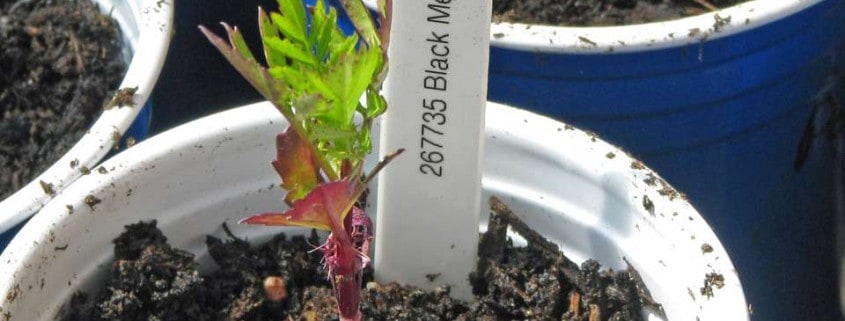
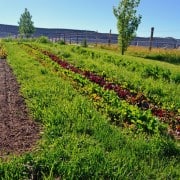

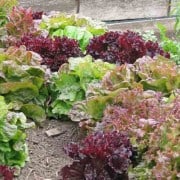
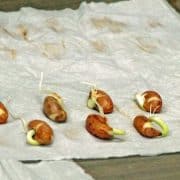
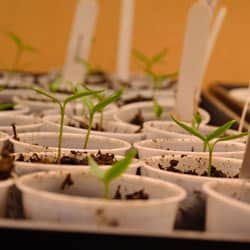
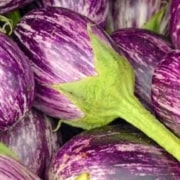 2019 Terroir Seeds | Underwood Gardens
2019 Terroir Seeds | Underwood Gardens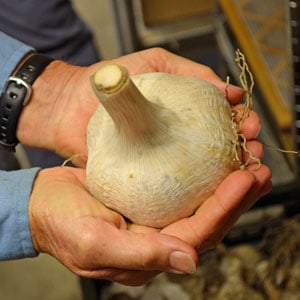
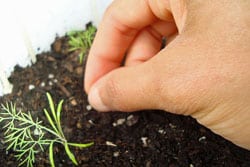
I received my seeds for Cucamelon, to try them for the first time. I started about 3 and was happy to see them start to sprout. Shortly after the first signs of sprouting, the sprouts disappeared. I did this again and the same thing happened. After further inspection, I found little tiny slugs were in residence and doing my babies in. I have since made up a spray bottle with a little salty solution to spray around the the bases of the starter pots, which sit up on some stones and my new sprouts have their first true leaves.
Thanks for sharing this Susan! Beer also works for slugs and snails, a shallow pan or even beer caps with a little in them.
Yeahhhh beer…not sharing. :)
Now that’s funny!
I work for a seed company (mainly ornamentals) and spend much time answering horticultural questions from customers on the phone. Your article gives me added confidence that I am asking the right questions of those folks whose seed starting experiences have failed. So frequently, I find that people fail to read the printed instructions on the seed packet, and just assume that whatever they do will work. They expect every seed to behave in the same way, expect tender heat lovers to pop up in a few days in cold soil and conversely, cool season types to germinate and grow well in warm summer conditions. When things don’t work out, they expect us to give them new seed or refund their money.
I also have spent much time testing seed varieties for optimum germination conditions. Sometimes more than one cold stratification protocol will work, but just one will produce the best results. Patience is definitely needed for many perennials (and even a few annuals); discarding trays of seeds prematurely is a common mistake. Many kinds will germinate in several periods, with a fairly lengthy break between in which no emergence is occuring.
Glad this was helpful Caroline, and thanks for sharing your experiences! You aren’t crazy, people just get in too big of a hurry in today’s digital, instant world and sometimes forget that not everything is instant.
Just love your articles. Thank you for sharing your pertinent knowledge for growing healthy vegetables.
You are welcome, Cathy! Glad our information is helpful for you.